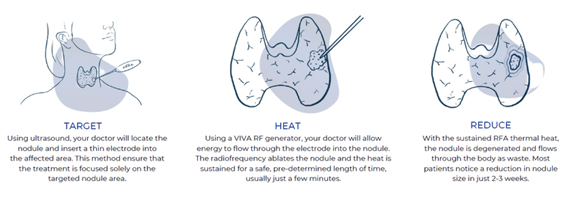
Thyroid Radiofrequency Ablation (RFA)
Thyroid Radiofrequency Ablation (RFA)
Contact Information:
Phone Number: 760-294-2705
Email: rfa@amcrclinic.com
What is Thyroid Radiofrequency Ablation (RFA)?
Thyroid RFA is a minimally invasive medical procedure that treats thyroid nodules. Using ultrasound-guided imaging, the nodule is located, allowing the treatment to focus solely on the targeted nodule area. Using a radiofrequency generator, your doctor allows a carefully controlled amount of energy to flow through the electrode into the tissue to ablate the nodule. With the sustained RFA thermal heat, the nodule is degenerated, allowing the degenerated tissue to flow through your body naturally as waste over the course of a few months.
Introduction to RFA At Our Center
The Thyroid Gland and Why It's Important
Our brains, hearts, and digestive and metabolic systems function normally with the help of one small gland: the thyroid gland.
Your butterfly-shaped thyroid gland is located at the front of your neck near the base of your throat, wrapping around your windpipe. The thyroid gland is part of your endocrine system, where it secretes hormones to regulate your body’s heart rate, blood pressure, temperature, and metabolism.
Thyroid Nodules and Common Symptoms
The majority of nodules are benign and not life-threatening. However, they can still cause problems, including discomfort, difficulty or pain when swallowing, production of excess thyroid hormones, swelling, and enlargement in the neck.
While surgery can be effective, the long-term effects of removing the thyroid are problematic for patients. Removing the thyroid gland altogether leaves a patient with unsightly scarring and a lifetime need for medication.

Why Choose Thyroid RFA?
Thyroid RFA is a minimally invasive, non-surgical treatment for undesirable thyroid nodules! This procedure is a quick, safe option that enables patients to resume normal daily activity with minimal recovery periods.
The term radiofrequency (RF) refers to an alternating electric current oscillating between 200 kHz and 1200 kHz. Application of Radiofrequency agitates tissue ions as they attempt to follow the changes in the direction of the alternating current, thus creating frictional heat around the electrode. Although heat creates immediate damage to the tissue, this is significant only in regions within a few millimeters of the electrode.
Benefits of Thyroid RFA
- Preserves your healthy thyroid tissue
- Allows your thyroid to function normally without the need for a lifetime of medication
- Minimally invasive procedure
- Performed under local anesthesia
- Performed as an out-patient procedure, which means no downtime or hospitalization
- Shorter recovery times
- No scarring
- Volume reduction
- Low complication rate
- Worldwide use
- Quality of life
Risks of Thyroid RFA
All treatments and procedures have risks, and these will be discussed in detail with you by your doctor.
Serious complications are rare. The main risks are bleeding, hoarse voice due to nerve bruising, skin burns, and infection. Infection can be a delayed problem and present with swelling, pain, and redness.
Rare serious complications can include damage to the food pipe (esophagus), windpipe(trachea), and nerves to the voice box (vocal cords). The risk of permanent injury to the voice box nerve leading to alteration in the voice is less than 1% (less than 1 in 100).
Larger nodules could require more than one treatment for effective nodule shrinkage. Your doctor will discuss the likelihood of needing additional treatments with you during your initial assessment.
How Thyroid RFA Works
To begin the procedure, a numbing agent will be applied around the thyroid gland. Once you’re relaxed and your neck is numb, a thin electrode is inserted and directed into the nodule under ultrasound guidance. Radiofrequency energy emitted from the electrode causes precise destruction of the targeted tissue. The electrode is systematically guided through the entire nodule, and the process is repeated until the nodule is completely treated.

Preparing for Thyroid RFA
Your healthcare provider will review any current medications you are taking and provide further instructions if needed. Other than blood thinners, which you will likely need to stop taking a few days prior to the procedure, most medications do not interfere with the procedure.
What to Expect on the Day of Your Thyroid RFA
You will be able to breathe, swallow and speak normally during the entire procedure. You will be asked to lie your head on a small cushion with your neck extended.
Your doctor will clean, prepare the skin and administer local anesthesia in the area surrounding your thyroid. Two grounding pads will be attached to your thighs. To ensure that you are handling the procedure well, your doctor may ask you how you are doing and whether or not you can feel any pain. They can easily make adjustments if you are uncomfortable at any time.
A small bandage will be placed on the treatment site when the procedure is complete, and your neck may be cooled with ice packs.
What to Expect After the STARmed Thyroid RFA
You will be monitored for a short period of time and then discharged. You will have to check with your doctor before you drive, as you may need someone to drive you to and from the procedure.You will be able to return to most of your day-to-day activities almost immediately.
What Happens to the Nodules After the Procedure?
After the procedure, the cells of the treated thyroid nodule are removed by the body's immune system. Most patients notice a reduction in nodule size in just 2 to 3 weeks, with solid nodules taking longer than cystic nodules.
The amount of reduction depends on the original size and nature of the nodules. After three months, the average reduction rate is 40% to 60% and about 60% to 90% reduction rate at the one-year mark.
Years after the procedure, only the scar tissues will remain in the treated area. The nodule around the scar may still remain, but this area will be minimized after the procedure. The surrounding healthy thyroid gland will be preserved and will continue to produce thyroid hormone.
Symptoms like difficulty swallowing, pressure or tightness in the throat, or a bulky nodular appearance are typically eliminated or significantly reduced.

Have Questions? We've Got Answers
Is the procedure painful?
Because local anesthesia is administered before the procedure, very few patients experience any pain at all. During the RFA, it’s normal to feel pushing and pressure in the neck, but the procedure generally does not cause pain. Patients occasionally feel heat or discomfort in the neck that may radiate to the ear or jaws. Following your procedure, you will be given ice packs and pain medication if needed. For more questions related to the procedure, please consult directly with your doctor.
How many treatments are necessary?
One procedure will sufficiently decrease the size of the nodules and improve symptoms, but If the treated nodules are close to vocal cord nerves or nodules are very large, additional procedures maybe necessary to decrease the nodule significantly. The untreated areas of nodules may impede the improvement of thyroid function so that complete ablation may be required, and more than one procedure may be needed.
Will the procedure leave a scar?
No. The procedure is delivered using a thin needle. There may be small markings on your neck from the needle for 1-2 days following the procedure, but it will not leave any visible scarring.
How effective is the procedure?
For benign nodules, clinical trials have shown an average radiofrequency ablation of benign cold nodules showed volume reductions of 32.7-58.2% at 1 month and 50.7-84.8% at 6 months while reducing symptoms and cosmetic problems.
RFA is effective over a four-year period in a long-term follow-up study, with nodules consistently decreasing by 93.5%.
Useful Resources
Patient Brochure
Your Journey With RFA
Contact Information:
Phone Number: 760-294-2705
Email: rfa@amcrclinic.com
